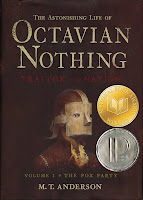Reading Recommendations: Children’s Lit
In what follows, Ph.D. candidate Natalia Cecire offers what she calls an “idiosyncratic list of recent (i.e. from the last ten years) children’s fiction that I’ve enjoyed, with a bias toward fantasy.” Natalia is the co-founder of the Children’s Literature Working Group and offers these recommendations as suggestions either to get your young niece or nephew into good but entertaining reading or to access your own inner child-reader.
***
 M.T. Anderson, The Astonishing Life of Octavian Nothing, Traitor to the Nation. Volume I: The Pox Party. Candlewick, 2006.
M.T. Anderson, The Astonishing Life of Octavian Nothing, Traitor to the Nation. Volume I: The Pox Party. Candlewick, 2006.- In colonial America, a boy grows up surrounded by scholars, trained extensively in Greek and Latin but unaware of his own origins. The outbreak of revolution leads to disturbing revelations about Octavian and his mother. Dark and Gothic in sensibility, it’s Johnny Tremain meets Vathek, taking a long, chilling look at the U.S.’s Enlightenment heritage. A sequel was released this year.
 Blue Balliett, The Wright 3. Scholastic, 2006. Illustrations by Brett Helquist.
Blue Balliett, The Wright 3. Scholastic, 2006. Illustrations by Brett Helquist.- This is the second of three mysteries by Balliett centering on famous works of art (the other two are Chasing Vermeer and The Calder Game). Balliett’s everything-is-connected! sensibility has resulted in comparisons to The Da Vinci Code, but I prefer to see it as a descendant of Thomas Pynchon’s paranoid fantasias, minus the bizarre sex scenes. In this volume, three middle-school students at the University of Chicago Laboratory School fight to save a local Frank Lloyd Wright masterpiece, the Robie House, which is (fictionally) in danger of being torn down. As the friends work together, Balliett offers sensitive insights into gender and class dynamics.
 Mary Hoffman City of Stars. Bloomsbury, 2003.
Mary Hoffman City of Stars. Bloomsbury, 2003.- Hoffman’s Stravaganza series features present-day Londoners who travel magically (“Stravagate”) to Renaissance Talia, the Italy of a parallel universe. In this, the second novel of the series, the protagonist is a fifteen-year-old girl named Georgia. Her main goals in life are to ride horses and to evade sexual harassment at the hands of her brutal step-brother Russell. When she learns to Stravagate to Talia, she becomes involved in dangerous political intrigues surrounding a magical winged horse. It turns out for Georgia that, once you’ve crossed the Medici family of an alternate universe, you become less scared of your jerk step-brother.
 Diana Wynne Jones, Dark Lord of Derkholm. Greenwillow, 1998.
Diana Wynne Jones, Dark Lord of Derkholm. Greenwillow, 1998.- In a parallel universe filled with magic, the people are under the thumb of an unscrupulous businessman, who sets up elaborate tours featuring every fantasy cliche in the book. Nerdy, bumbling Derk is selected as this year’s Dark Lord; with his large, genetically engineered, multispecies family, he has to pull off a convincing performance while trying to figure out how to stop the tours forever. Jones lovingly and hilariously mocks the cliches of the sword-and-sorcery genre. Jones is also the author of Howl’s Moving Castle, which was adapted to film by Hayao Miyazaki a few years ago.
 Gail Carson Levine, The Two Princesses of Bamarre. HarperCollins, 2001.
Gail Carson Levine, The Two Princesses of Bamarre. HarperCollins, 2001.- Two sisters, princesses both, are the best of friends. Meryl is a sword-wielding tomboy; Addie is painfully shy. Meryl has always protected Addie, but when a magical plague strikes Meryl down, Addie must be the one to save her. Suddenly she is forced to fight dragons, wear seven-league boots, and of course, wield her bad-ass embroidery needle. An interesting negotiation between difference feminism and the third wave (with princesses), this novel is both literally and figuratively about sisterhood.
